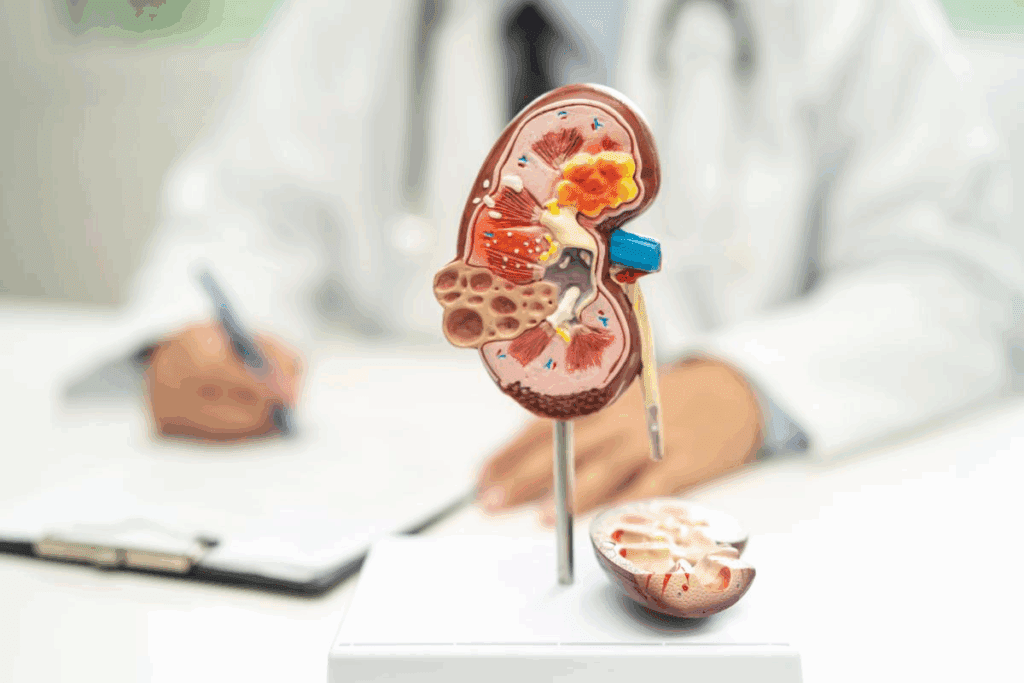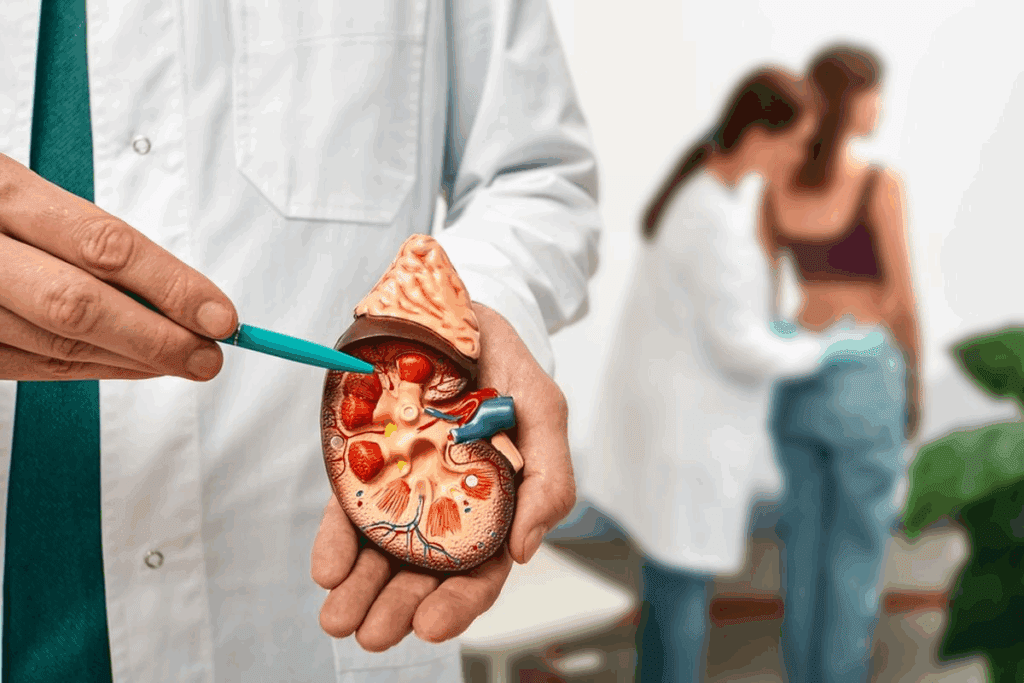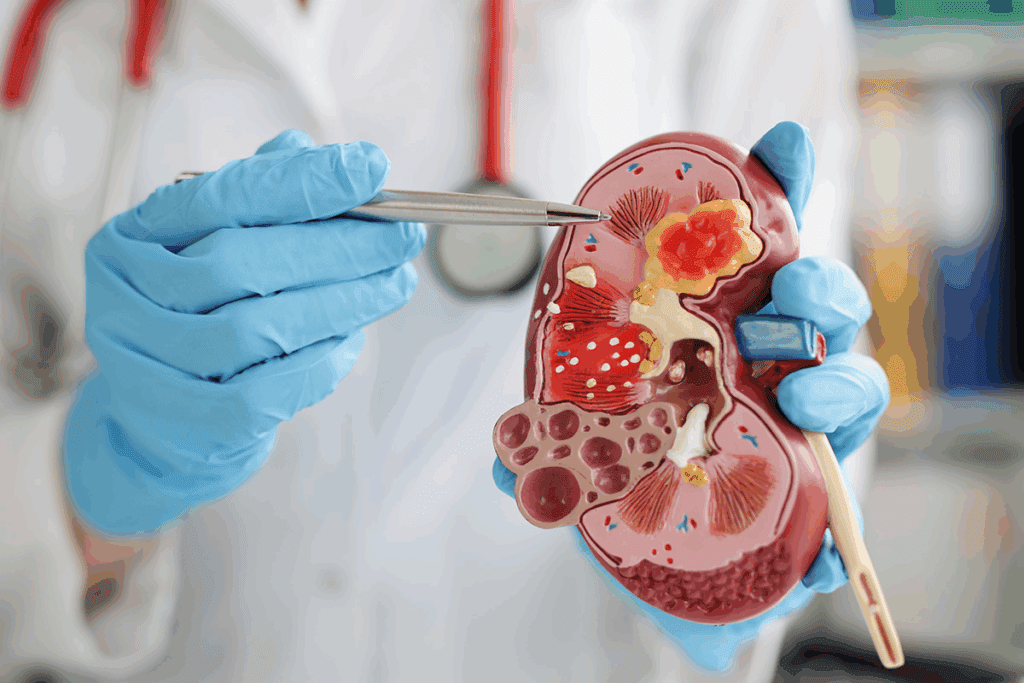Last Updated on November 6, 2025 by Bilal Hasdemir

Seeing a kidney stone in the toilet can feel both relieving and confusing. Many ask, can you see kidney stones in the toilet, and at Liv Hospital, we know how key it is to spot these stones. This helps avoid them in the future and tackle the reasons behind them.
Kidney stones are hard, pebble-like masses made of minerals and crystals. They form when there’s too much of certain minerals in urine. When a stone passes, it can be a big relief. But knowing what to look for is very important for doctors to analyze.
The look of these stones can change a lot, depending on what they’re made of and how fast they form. They can range from tiny grains of sand to bigger stones. Knowing what they look like helps people spot them and act quickly.

To understand kidney stones, we need to know what they are made of and how they form. These stones are hard deposits of minerals and salts in the kidneys. The mix of minerals in the stone can change its look and how it acts.
Kidney stones, or renal calculi, are solid masses of crystals in the kidneys. They form when there’s an imbalance of minerals in the urine. Kidney stones can cause severe pain and may need medical help if they don’t pass on their own.
The making of kidney stones involves several things. These include supersaturation of urine with stone-forming salts, not drinking enough water, and genetics. When urine gets too concentrated, minerals can turn into stones.
Kidney stones are mainly made of minerals like calcium oxalate, uric acid, and struvite. The most common is calcium oxalate stones. These are linked to what we eat and how much water we drink.
| Type of Stone | Common Composition | Characteristics |
| Calcium Oxalate | Calcium and oxalate | Most common type, often associated with diet and hydration |
| Uric Acid | Uric acid | More common in men, associated with gout and metabolic syndrome |
| Struvite | Magnesium ammonium phosphate | Often associated with urinary tract infections (UTIs) |

Kidney stones start in the kidneys and travel through the urinary system to the toilet. This journey can be painful. It may cause severe back or side pain, nausea, and changes in how you urinate.
Kidney stones form in the kidneys due to various reasons like mineral concentration, dehydration, or genetics. When a stone grows big enough, it begins its journey through the urinary system.
The urinary system includes the kidneys, ureters, bladder, and urethra. The stone moves from the kidney to the ureter, a narrow tube. It then goes to the bladder and exits the body through the urethra during urination.
Passing a kidney stone can be very painful. Symptoms include severe back or side pain, pain in the lower abdomen, a burning feeling when you urinate, and changes in urine color or clarity.
The pain can change in intensity and location as the stone moves. Knowing these symptoms helps prepare for the experience and when to get medical help.
The pain from passing kidney stones can vary. It depends on the stone’s size and where it is in the urinary system.
| Stone Location | Typical Pain Level | Associated Symptoms |
| Kidney | Severe | Back or side pain, nausea |
| Ureter | Very Severe | Radiating pain to lower abdomen, frequent urination |
| Bladder/Urethra | Mild to Moderate | Burning sensation during urination, changes in urine color |
Knowing about kidney stone pain and their journey helps cope better. It also guides when to seek medical care.
Spotting kidney stones in the toilet is key to knowing your kidney health. Looking at a stone can tell you about its size, texture, and what it’s made of.
Kidney stones come in all sizes. They can be tiny, like a grain of sand, or big, like a pearl. The size of the stone affects how much pain it causes. Bigger stones can hurt more and might cause more problems.
Kidney stones can feel smooth or rough. Some have a shiny, crystalline look, while others seem solid. The stone’s surface can hint at its type. For example, rough stones might irritate more during passage.
Many kidney stones show crystalline structures up close. These details help figure out the stone’s type. Knowing the stone’s structure is key to understanding its makeup, which helps prevent more stones.
A medical expert says, “The look of a kidney stone can tell you a lot about its makeup.” This shows why it’s important to check out stones you pass. It helps you understand your kidney health better.
“The appearance of a kidney stone can reveal a lot about its composition and the underlying causes of its formation.”
Looking closely at a passed kidney stone can teach you a lot. This knowledge is very helpful when talking to doctors for advice and treatment.
Kidney stones look different based on what they’re made of. They come in various types, each with its own look. Knowing these differences helps you spot the stones you pass.
We’ll look at the most common types of kidney stones. We’ll talk about their looks and what they tell us about their makeup.
Calcium oxalate monohydrate stones are very common. They look dark and spiky. Their surface is rough, and they’re quite hard.
Characteristics: Dark color, spiky surface, hard texture.
Calcium oxalate dihydrate stones are lighter in color and rounder. They’re often described as having a mulberry-like texture. They’re softer than monohydrate stones.
Characteristics: Lighter color, rounded surface, mulberry-like texture.
Calcium phosphate stones are smooth and white or light-colored. They form in alkaline urine and are linked to certain health issues.
Characteristics: Smooth surface, white or light color.
Uric acid stones are yellow or brown. They can be smooth or rough. They form in acidic urine and are linked to gout.
Characteristics: Yellow or brown color, variable surface texture.
| Type of Stone | Appearance | Characteristics |
| Calcium Oxalate Monohydrate | Dark, spiky | Hard, rough surface |
| Calcium Oxalate Dihydrate | Lighter, rounded | Mulberry-like texture, less hard |
| Calcium Phosphate | White or light, smooth | Smooth surface, associated with metabolic conditions |
| Uric Acid | Yellow or brown, variable | Smooth or rough, associated with gout |
Knowing about the different types of kidney stones and their looks helps you identify them. If you’ve passed a stone, see a doctor. They can tell you what kind it is and how to prevent more.
Kidney stones come in many colors, each telling us something about their makeup. Looking at the colors of stones passed in the toilet helps us understand their mineral content and possible causes.
Yellow and brown stones are common. They are often made of uric acid or calcium oxalate. Uric acid stones look yellow or orange, while calcium oxalate stones can be brown to dark brown.
White or cream-colored stones are usually calcium phosphate. These stones might show a problem with calcium or pH levels in the urine.
Dark or black stones have high oxalate or impurities. These hard stones can be very painful to pass.
Reddish or orange stones might have blood or other substances. Blood in these stones suggests irritation or damage to the urinary tract.
To understand how stone composition relates to color, let’s look at a table:
| Stone Composition | Common Color(s) |
| Uric Acid | Yellow, Orange |
| Calcium Oxalate | Brown, Dark Brown |
| Calcium Phosphate | White, Cream |
| Presence of Blood or Impurities | Reddish, Orange, Dark Brown, Black |
The table shows how color can hint at a stone’s makeup. Knowing these colors helps people identify their stones and get the right medical advice.
Watching kidney stones in the toilet can be fascinating. It’s not just a curiosity; it tells us about the stones’ makeup.
The buoyancy of kidney stones depends on their density. Denser stones sink, while less dense ones float. The stone’s mineral makeup affects its density.
For example, calcium oxalate monohydrate stones are denser than uric acid stones. Knowing this can help figure out what kind of stone someone has passed.
Stones that float are likely less dense, possibly made of uric acid. Stones that sink are denser, often calcium oxalate or other minerals.
This isn’t always true. Many factors can influence this, like air pockets in the stone or its mineral mix.
Each type of kidney stone has a different density because of its unique makeup. For example:
Knowing about the density and buoyancy of kidney stones is important. It helps patients and doctors understand the stone type and what might have caused it.
Kidney stones can show up in different ways, like small pieces or color changes on toilet paper. When you pass a stone, you might see things that look strange or scary.
After passing a stone, you might find small pieces on the toilet paper. These pieces can be tiny or bigger, depending on the stone’s size and how it broke.
It’s hard to tell if they’re stone fragments or something else. But, stone pieces usually feel solid and might look like crystals.
Seeing blood on the toilet paper is common with kidney stones. It means the stone might have irritated or slightly hurt the lining of your urinary tract.
The blood color can range from bright red to darker, based on how much blood there is and how long it’s been in your urine.
It’s tricky to tell if something on the toilet paper is a kidney stone fragment. But, there are some clues to help you figure it out.
| Feature | Kidney Stone Fragments | Other Substances |
| Texture | Solid, possibly crystalline | Varies (soft to hard) |
| Color | Typically yellow, brown, or white | Varies widely |
| Shape | Irregular, possibly jagged | Varies |
Knowing these differences can help you spot kidney stone fragments on the toilet paper. It makes it easier to tell them apart from other things.
Kidney stones in the toilet can be a surprise. Knowing what to look for is key. We’ll show you how to spot kidney stones, including the differences between men and women. We’ll also explain how to tell stones from food and what blood means when it comes with stones.
Men and women pass kidney stones differently. Men are more likely to get kidney stones than women. Their stones can also be different.
A study in the Journal of Urology found men have more calcium oxalate stones. Women tend to have calcium phosphate stones. Knowing this can help doctors treat you better.
“The characteristics of kidney stones can vary significantly between men and women, highlighting the importance of personalized medical care.”
Medical Expert, Urologist
It can be hard to tell kidney stones from food in the toilet. Stones are hard and have distinct colors and textures. Food particles are softer and more irregular.
Passing a kidney stone can sometimes cause blood in the urine, known as hematuria. This is common but can be scary.
Blood means the stone might have irritated or damaged the urinary tract. If you see a lot of blood or have a lot of pain, get help right away.
Identifying kidney stones in the toilet needs knowledge of their look, the differences between men and women, and how to tell them from other things. Understanding these can help you manage your condition and get the right medical care.
After passing a kidney stone, it’s important to collect and preserve it for medical analysis. This process might seem hard, but it’s key to understanding your stone and preventing more.
Collecting your kidney stone lets your doctor check its makeup. This is vital for finding out why it formed. It helps in creating a plan to stop it from happening again.
To collect a kidney stone, follow these steps:
After collecting the kidney stone, it’s key to store it right. You can put it in a clean container, like a plastic bag or a specimen container. Keep it safe until you can give it to your healthcare provider.
Doctors can learn a lot from your kidney stone. They can see what it’s made of and why it formed. This helps them find out if there are other health issues that might be causing stones.
By working with your healthcare provider and following their advice, you can lower your risk of getting more kidney stones.
Knowing when to seek medical help after passing a kidney stone is key. It can make a big difference in your recovery. Even though passing a stone is a relief, it’s important to watch your health closely.
Keep an eye out for unusual signs or symptoms after passing a stone. Look for:
If you notice any of these, get medical help right away.
Some situations after passing a stone are medical emergencies. If you face any of these, call for immediate help:
| Situation | Symptoms |
| Severe Infection | High fever, chills, confusion |
| Obstruction | Severe pain, inability to urinate |
| Heavy Bleeding | Large amounts of blood in urine |
When you see your doctor after passing a stone, be ready to share details. Tell them about:
“Your symptoms, like how long and how bad the pain is, can help your doctor understand your situation.”
Also, let them know about any medicines you’re taking and your health history.
Getting follow-up care is important after passing a stone. Your doctor might suggest:
Following your doctor’s advice can help prevent another stone from forming.
We’ve looked into kidney stones, how they form, and what they look like in the toilet. Knowing what to look for is key to handling them well. This knowledge helps people take steps to prevent them from coming back.
Spotting kidney stones early can change how we treat and prevent them. By studying these stones, we learn more about why they form. This info helps us make better choices about our diet and health.
Managing kidney health is all about being proactive. It’s important to know the signs of kidney stones and get help when needed. By staying informed, we can protect our kidneys and make smart health choices.
Yes, a stone’s color can hint at its makeup. For example, yellow or brown stones are often calcium oxalate, while uric acid stones might be reddish or orange.
Kidney stones move from the kidneys to the ureters, then to the bladder, and out through the urethra during urination.
Seek immediate medical help for severe abdominal or back pain, vomiting, fever, chills, or trouble urinating.
Kidney stones are hard and irregular, while food particles are softer and more broken down. If unsure, it’s best to ask a healthcare professional.
National Center for Biotechnology Information. (2025). What Do Kidney Stones Look Like in the. Retrieved from https://www.ncbi.nlm.nih.gov/pmc/articles/PMC3811151/
Subscribe to our e-newsletter to stay informed about the latest innovations in the world of health and exclusive offers!
WhatsApp us